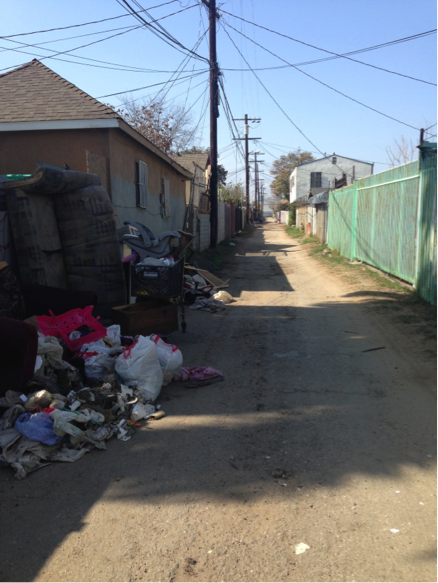Walk down an alley in South Los Angeles and you can expect to see old furniture and scattered trash piled on cracked pavement. You’ll hear dogs barking incessantly and smell standing water. And you’ll rarely come across a fellow pedestrian. An environmental initiative currently in the works, however, seeks to change this reality by turning those neglected alleys into clean walkways sprouting with native plants.
“If residents see that their city is investing in them, we can really build a better quality neighborhood all around,” said Connie Llanos, spokeswoman for councilman Curren Price of the 9th District.
The Green Alley Program, slated to break ground late this year, will transform alleys of blight into welcoming open spaces. The Bureau of Sanitation partnered with city districts within South L.A. and the Trust for Public Land, a non-profit that develops parks throughout the nation, to spearhead the program.
Los Angeles is one of the most park-poor cities in the nation, says a study by the USC Center for Sustainable Cities, with only 7.8 percent of the city devoted to open spaces. In other major cities like Chicago, according to the City of Chicago Green Alley Program website, 8.5 percent of land is devoted to park space. In low-income communities like South L.A.’s 9th District, the number of parks is significantly fewer, while the rate of poverty is among the highest in the city.
Meanwhile, South L.A. is home to the greatest percentage of the city’s alleys — nearly one third. That’s because South L.A. is one of the oldest parts of the city. At one time, alleys were used for garbage collection and goods deliveries as a way to reduce traffic on the main streets in the year’s following World War II. Today, because of the high poverty rate and the lack of a functional use for them, the alleys have become a place for drug dealing and other crimes, said Llanos.
“Right now [the alleys] are a tremendous eyesore,” Llanos said. “But we can utilize them and clean them up when we use them as a place for families to congregate and play.”
Two alleys have already been identified for transformation under the project. One is sandwiched between 53rd and 54th Streets in between San Pedro and Main streets. The other snakes between 51st and 52nd Streets between Towne and Avalon boulevards.

The alley between 53rd and 54th streets at San Pedro and Main streets is slated for transformation into a green space for residents to walk and play. | Jordyn Holman
According to TPL, these alleys will be more ecologically friendly. Their new paving will allow rainwater to infiltrate the ground, preventing standing water. The permeable paving will also help nourish the fruit trees and native species that will be planted along the alleys, creating mini-parks. Streetlights and crosswalks will be added to ensure safe passage for pedestrians.
Planners hope the beautification improvements will encourage locals to get out of doors. Currently, several neighborhood organizations, like Challengers Boys and Girls Club of America, run their programs indoors because of safety concerns.
Challengers offers athletic programs and academic support to children in South L.A. The group’s building and its amenities give children a place to play that’s safer than they could find outdoors, said Diane Jones, director of development.
“Everything else is gloom and doom,” Jones said, referring to the surrounding community of Jefferson Park and West Adams. “The community needs someplace where [people] can walk and feel safe.” As it is, she said, “No one is going to go outside and take a walk.”
Jones said the plan for more green spaces within South Los Angeles would enhance the wellbeing of the residents, particularly children.
“People need fresh air because it’s healthier — mentally, physically and emotionally,” Jones said.
The Green Alley Program is not the first ecologically friendly project to take root in the area. The program joins a growing list of more than 14 green initiatives aimed at improving residents’ quality of life. L.A. Audubon’s Baldwin Hills Program, which educates South Los Angeles teenagers about the local environment, is among them. Stacey Vigallon, program director, said exposure to healthy outdoor environments within the city limits is crucial.
“Green space and open space, especially in the city, is essential to physical fitness,” said Vigallon. “Plus, it also makes people more accountable to their community.”
Though green alleys may benefit the environment, many stakeholders believe the ultimate accomplishment will be increased interaction amongst neighbors. In order to maintain the alleys, Kjer said, residents will form “green teams,” which will be responsible, along with the city, for the upkeep of their nearby alleys.
Kjer believes this element will be crucial in building stronger community ties.
“People who might not have talked to one another or paid attention to their community before are now active and paying attention to cleanup and taking ownership of their community into their own hands,” Kjer said.
Though TPL and the city are currently focused on rolling out the program solely in South L.A., planners believe the impact of the green alleys will extend far beyond the area. The Trust for Public Land said that, although not all of L.A.’s alleys will get a full renovation, many will be improved in some way.
“There are 900 miles of alleys in Los Angeles,” Kjer said. “Green alleys should become the standard.”
One of the alleys slated for greening:
Challengers Boys and Girls Club:
Like Intersections on Facebook, follow us on Twitter and sign up for the Newsletter to stay in the loop on news and views from South LA.














